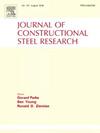SCF formulae of corrugated-web steel girders: Experiments and numerical analysis
IF 4
2区 工程技术
Q1 CONSTRUCTION & BUILDING TECHNOLOGY
引用次数: 0
Abstract
To facilitate the fatigue design of corrugated-web steel girders (CWGs) utilising the hot spot stress method, this study presents an experimental and numerical investigation of the hot spot stress concentration factors (SCFs) of trapezoidal corrugated-web steel girders (TCWGs) and sinusoidal corrugated-web steel girders (SCWGs) under uniform bending. Static test results indicate that the stress concentration on the flange of TCWGs can be effectively diminished by reducing the corrugation angle and length, and increasing the corner radius. The SCF of SCWGs is markedly lower than that of TCWGs, with the measured SCF of the latter being approximately 1.15 to 1.32 times higher than that of the former. Finite element (FE) models of TCWGs and SCWGs with welded seams were developed using ABAQUS software. A method for calculating the dimensions of the hot spot stress extrapolation region was proposed. This method enabled high-quality meshing in the extrapolated region, ensuring that the positions of the test gradient strain gauges were precisely determined in the FE models. Utilising the test-validated FE models, parametric analyses of SCF in the constant bending region of TCWGs and SCWGs were conducted. The parametric studies of the SCFs of TCWGs and SCWGs considered the effects of seven and four dimensionless parameters, respectively. Calculation formulae for SCFs of TCWGs and SCWGs under uniform bending were proposed using regression analysis. The validity of these formulae was confirmed by comparing them with test and FE results.
求助全文
约1分钟内获得全文
求助全文
来源期刊

Journal of Constructional Steel Research
工程技术-工程:土木
CiteScore
7.90
自引率
19.50%
发文量
550
审稿时长
46 days
期刊介绍:
The Journal of Constructional Steel Research provides an international forum for the presentation and discussion of the latest developments in structural steel research and their applications. It is aimed not only at researchers but also at those likely to be most affected by research results, i.e. designers and fabricators. Original papers of a high standard dealing with all aspects of steel research including theoretical and experimental research on elements, assemblages, connection and material properties are considered for publication.
 求助内容:
求助内容: 应助结果提醒方式:
应助结果提醒方式:


